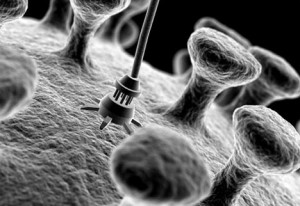Despite its versatility, protein has shortcomings as an engineering material. Protein machines quit when dried, freeze when chilled, and cook when heated. We do not build machines of flesh, hair, and gelatin; over the centuries, we have learned to use our hands of flesh and plastic. We will do likewise in the future. We will use protein machines to build nanomachines of tougher stuff than protein.
As nanotechnology moves beyond reliance on proteins, it will grow more ordinary from an engineer’s point of view. Molecules will be assembled like the components of an erector set, and well-bonded parts will stay put. Just as ordinary tools can build ordinary machines from parts, so molecular tools will bond molecules together to make tiny gears, motors, levers, and casings, and assemble them to make complex machines.
Parts containing only a few atoms will be lumpy, but engineers can work with lumpy parts if they have smooth bearings to support them. Conveniently enough, some bonds between atoms make fine bearings; a part can be mounted by means of a single chemical bond that will let it turn freely and smoothly. Since a bearing can be made using only two atoms (and since moving parts need have only a few atoms), nanomachines can indeed have mechanical components of molecular size.
How will these better machines be built? Over the years, engineers have used technology to improve technology. They have used metal tools to shape metal into better tools, and computers to design and program better computers. They will likewise use protein nanomachines to build better nanomachines. Enzymes show the way: they assemble large molecules by “grabbing” small molecules from the water around them, then holding them together so that a bond forms. Enzymes assemble DNA, RNA, proteins, fats, hormones, and chlorophyll in this way — indeed, virtually the whole range of molecules found in living things.
Biochemical engineers, then, will construct new enzymes to assemble new patterns of atoms. For example, they might make an enzyme-like machine which will add carbon atoms to a small spot, layer on layer. If bonded correctly, the atoms will build up to form a fine, flexible diamond fiber having over fifty times as much strength as the same weight of aluminum. Aerospace companies will line up to buy such fibers by the ton to make advanced composites. (This shows one small reason why military competition will drive molecular technology forward, as it has driven so many fields in the past.)
By KEVIN ULMER Director of Exploratory Research
Genex Corporation
Engines of Creation 2.0

Trackback: Frankie
Trackback: Alexander7